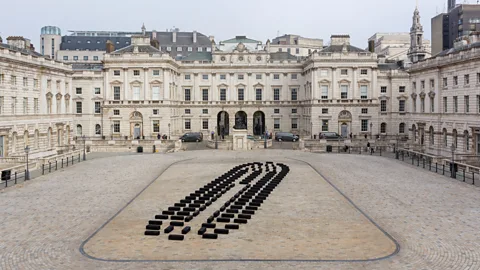The slave ship in a London courtyard
 Tim Bowditch
Tim BowditchA new installation of 140 blocks of wood summons up a forgotten history, writes Melissa Chemam.
Laid out on the stone courtyard of London's Somerset House, like the fossilised remains of a whale, there is the outline of a slave ship. Made up of 140 blocks of charred wood, it is O Barco / The Boat by Grada Kilomba, a Portuguese writer and interdisciplinary artist of African descent (from Sao Tome and Angola). Forming the shape of the bottom of a boat, the piece references the slave ships that carried for centuries millions of Africans, enslaved by European empires. The blocks also contain poems in six different languages, inscribed on the surface. "Addressing the history of European maritime expansion and colonisation, the piece invites the audience to consider forgotten stories and identities," the curators explain; the civil istration responsible for the British Royal Navy was once based at Somerset House.
O Barco was originally created in 2021, and now appears in London, presented by Somerset House on the 10th anniversary of the 1-54 fair dedicated to contemporary African art. The artwork is accompanied by live performances made up of song, music and dance. "I would call it many things," Kilomba tells BBC Culture, "a sculpture, an installation, a performance and poetry. I'm not interested in one discipline in particular, but in telling stories… I first worked around the Greek myth of Antigone, a woman whose two brothers kill each other for power. The new king, Creon, allows only one to be buried in the city, while the other one is left to the dogs. To me, it became an important story about ceremony and memory, and human dignity."
Kilomba is also a lecturer, teaching post-colonial studies and psychoanalysis at institutions including the Free University of Berlin, Bielefeld University, and the University of Ghana. "The story of Antigone interrogates values that resonate, to me, with the stories of current humanity," she continues. "It asks: 'When are we respected bodies">window._taboola = window._taboola || []; _taboola.push({ mode: 'alternating-thumbnails-a', container: 'taboola-below-article', placement: 'Below Article', target_type: 'mix' });
